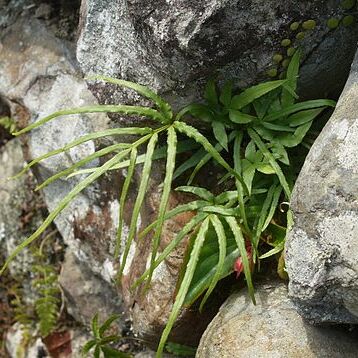Stems slender, short-creeping, densely scaly; scales dark reddish brown to chestnut brown. Leaves clustered, 1--6 dm. Petiole pale or brownish, 5--30 cm, scaly proximally, otherwise glabrous. Blade oblong to oblanceolate, irregularly and pedately divided proximally (as in Pteris cretica ) and pinnately divided distally, 10--35 × 13--25 cm; rachis slightly and evenly winged, wing constricted above each pinna pair. Pinnae 3--7 pairs, widely spaced, distal pinnae simple, adnate and decurrent to rachis; pinnae remaining green through winter, not articulate to rachis, lanceolate to linear; sterile pinnae wider than fertile pinnae (to ca. 1.2 cm), margins irregularly serrate to serrulate; fertile pinnae mostly less than 5 mm, margins entire to serrate at apex; adaxial costae with sparse, septate hairs; proximal pinnae with 1--4 elongate basal segments. Veins free, simple or forked. Sori narrow, blade tissue exposed abaxially. 2 n = 116.
Herbaceous fern. Rhizome short, slender, densely covered with dark brown or reddish brown scales. Fronds tufted, erect, 5–45 (–60) cm long. Stipe usually more than half the frond length (shorter on sterile fronds), slender, brown or straw-coloured, deeply grooved, mostly glabrous. Lamina irregularly 2-pinnate, lowermost pairs pedately divided (sterile fronds 1-pinnate), dark to light green, almost glabrous; rachis straw coloured, winged for most of length, glabrous or with scattered brown scales. Pinnae in 2–4 overlapping pairs, 40–140 (–190) mm long, 3–6 mm wide, linear or lanceolate, apex tapering, base long decurrent, margins serrate or serrulate, becoming entire when fertile; veins widely spaced at maturity, almost parallel, simple or forked. Sori continuous along margins extending down decurrent base.
A fern. It has a creeping rhizome. The fronds are small and divided 2 or 3 times. The segments are long, narrow and of a thin texture.

